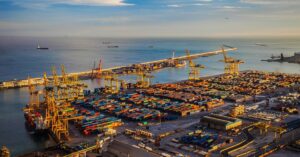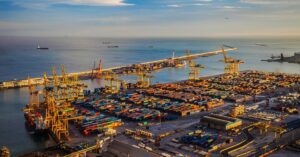
Scientists Discover Underground Ocean 3 Times Larger Than All Surface Oceans Combined
October 4, 2024
Containership Damaged After Hitting Pier In Columbia’s Barranquilla Port
October 4, 2024

Ports on the East and Gulf coasts of the United States reopened late on October 3, 2024, after dockworkers and port management negotiated a tentative wage agreement, ending the largest labour strike in over 50 years.
While the strike ended earlier than expected, experts warn that the cargo backlog will take weeks to clear.
The work stoppage, which began on October 1 and comprised 45,000 International Longshoremen’s Association (ILA) workers, disrupted operations at 36 ports from Maine to Texas.
Over 54 container ships were reportedly stopped outside the ports, unable to unload the cargo, posing a risk of shortages of items such as bananas and auto parts.
Per the Everstream Analytics, the number was calculated as of 4:00 p.m. ET (2000 GMT), with more ships set to arrive in the coming days.
Xeneta, a freight rate platform, estimates that normal cargo flow will take two to three weeks to return. Xeneta’s chief analyst, Peter Sand, talked about the difficulties of resuming operations, stating that workers will have to deal with both the backlog and the continuous arrival of new ships.
The tentative deal negotiated between the ILA and port operators represented by the United States Maritime Alliance (USMX) involves a 62% salary increase over six years, increasing hourly pay from $39 to $63.
However, both sides are still negotiating other crucial issues, such as port automation, that workers believe may result in job losses.
As the strike ended, global shipping stocks fell. The possibility of an extended strike had earlier boosted shipping firm shares in Asia and Europe, but those gains were reversed with the end of the strike.
Major drops included Japan’s Nippon Yusen, which fell by 9%, while Kawasaki Kisen and Mitsui O.S.K. Lines fell by 9.5% and 7%, respectively. South Korea’s HMM saw a 6.6% drop, while A.P. Moeller-Maersk in Europe fell 7.7%.
Analysts at JP Morgan estimated that the strike could cost the U.S. economy $5 billion per day.
Retailers, including major companies like IKEA, Home Depot, and Walmart, rely heavily on East and Gulf Coast ports, responsible for over half of all container shipping traffic.
Despite the deal, concerns about rising prices for some items, such as coffee, remain. East Coast ports are crucial destinations for these shipments, and the disruptions have already raised costs.
The National Retail Federation praised the deal, saying that reopening the ports is crucial to the US economy. However, the federation discussed the importance of reaching a final agreement to avoid further disruptions.
Reference: Reuters, U.S. News
U.S. East & Gulf Coast Ports Reopen After Historic Strike, Leaving Over 54 Ships In Queue appeared first on Marine Insight – The Maritime Industry Guide
Source: Maritime Shipping News


